

Getting Started Guide
Chapter
12
Creating Web Pages
Saving Documents as HTML Files
This document is Copyright © 2010 by its contributors as listed below. You may distribute it and/or modify it under the terms of either the GNU General Public License (http://www.gnu.org/licenses/gpl.html), version 3 or later, or the Creative Commons Attribution License (http://creativecommons.org/licenses/by/3.0/), version 3.0 or later.
All trademarks within this guide belong to their legitimate owners.
Contributors
Ron Faile Jr.
Feedback
Please direct any comments or suggestions about this document to: documentation@libreoffice.org
Acknowledgments
This chapter is based on Chapter 12 of Getting Started with OpenOffice.org. The contributors to that chapter are:
Agnes
Belzunce Peter Hillier-Brook
Ian Laurenson Peter Kupfer
Jean
Hollis Weber Linda Worthington
Publication date and software version
Published 30 December 2010. Based on LibreOffice 3.3.
Some keystrokes and menu items are different on a Mac from those used in Windows and Linux. The table below gives some common substitutions for the instructions in this chapter. For a more detailed list, see the application Help.
|
Windows/Linux |
Mac equivalent |
Effect |
|
Tools → Options menu selection |
LibreOffice → Preferences |
Access setup options |
|
Right-click |
Control+click |
Opens a context menu |
|
Ctrl (Control) |
z (Command) |
Used with other keys |
|
F5 |
Shift+z+F5 |
Opens the Navigator |
|
F11 |
z+T |
Opens the Styles & Formatting window |
Contents
Relative and absolute hyperlinks 4
Saving Writer documents as web pages 8
Saving a document as a single web page 8
Saving a document as a series of web pages 9
Creating web pages using a Wizard 9
Saving Calc spreadsheets as web pages 13
This chapter describes how to do the following in Writer, Calc, Draw and Impress:
Create hyperlinks within a document and to other documents such as web pages, PDFs, and other files.
Save documents as web pages (HTML documents).
When creating a document that you plan to deliver as a web page, you need to consider the following:
In an HTML document, hyperlinks are active (clickable) but other cross-references inserted by LibreOffice are not active links.
An object such as a image is saved as a separate file. However, if that object has been placed in a frame (for example, with an associated caption), it is not saved and does not appear in the HTML document; instead, the name of the frame appears.
Relative and absolute hyperlinks
Hyperlinks stored within a file can be either relative or absolute.
A relative hyperlink says, Here is how to get there starting from where you are now (meaning from the folder in which your current document is saved) while an absolute hyperlink says, Here is how to get there no matter where you start from.
An absolute link will stop working if the target is moved. A relative link will stop working if the start and target locations change relative to each other. For instance, if you have two spreadsheets in the same folder linked to each other and you move the entire folder to a new location, an absolute hyperlink will break but a relative one will not.
To change the way that LibreOffice stores the hyperlinks in your file, select Tools → Options → Load/Save → General and choose if you want URLs saved relatively when referencing the File System, or the Internet, or both.
Calc will always display an absolute hyperlink. Don’t be alarmed when it does this even when you have saved a relative hyperlink—this ‘absolute’ target address will be updated if you move the file.
|
Note |
Make sure that the folder structure on your computer is the same as the file structure on your web server if you save your links as relative to the file system and you are going to upload pages to the Internet. |
|
Tip |
When you rest the mouse pointer on a hyperlink, a help tip displays the absolute reference, since LibreOffice uses absolute path names internally. The complete path and address can only be seen when you view the result of the HTML export (saving the spreadsheet as an HTML file), by loading the HTML file as Text, or by opening it with a text editor. |
When you type text (such as a website addresses or URL) that can be used as a hyperlink, and then press the spacebar or the Enter key, LibreOffice automatically creates the hyperlink and applies formatting to the text (usually a color and underlining). If this does not happen, you can enable this feature using Tools → AutoCorrect Options → Options and selecting the URL Recognition option.
If you do not want LibreOffice to convert a specific URL to a hyperlink, choose Edit → Undo Insert from the menu bar or press Control+Z immediately after the formatting has been applied.
|
Tip |
To change the color of hyperlinks, go to Tools → Options → LibreOffice → Appearance, scroll to Unvisited links and/or Visited links, pick the new colors and click OK. Caution: this will change the color for all hyperlinks in all components of LibreOffice; this may not be what you want. In Writer and Calc (but not Draw or Impress), you can also change the Internet link character style or define and apply new styles to selected links. |
You can also insert hyperlinks using the Navigator and the Hyperlink dialog, and you can modify all hyperlinks using the Hyperlink dialog as described in this section.
The easiest way to insert a hyperlink to another part of the same document is by using the Navigator:
Open the documents containing the items you want to cross-reference.
Open
the Navigator by clicking its icon
![]() ,
by choosing View
→
Navigator, or
by pressing F5.
,
by choosing View
→
Navigator, or
by pressing F5.
Click the arrow next to the Drag Mode icon, and choose Insert as Hyperlink. (See Figure 1.)
In the list at the bottom of the Navigator, select the document containing the item that you want to cross-reference.
In the Navigator list, select the item that you want to insert as a hyperlink.
Drag the item to where you want to insert the hyperlink in the document. The name of the item is inserted in the document as an active hyperlink.
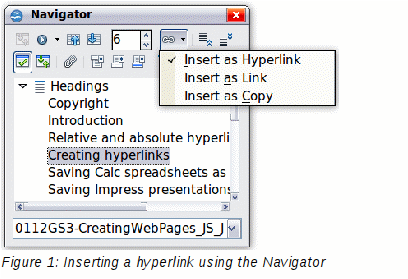
When using the Navigator to hyperlink to an object such as a graphic, to have the hyperlink show useful text such as 2009 Sales Graph, you need to give such objects useful names instead of leaving them as the default names (“Graphics6”), or you need to edit the resulting link text using the Hyperlink dialog, as described below.
You can also use the Navigator to insert a hyperlink from one document (the source) to a specific place in another document (the target). Open the Navigator in the target document and drag the item to the spot in the source document where you want the hyperlink to appear.
To
display the dialog, click the Hyperlink
icon
![]() on the Standard toolbar
or choose Insert
→
Hyperlink from the menu bar. To turn existing text
into a link, highlight it before opening the dialog.
on the Standard toolbar
or choose Insert
→
Hyperlink from the menu bar. To turn existing text
into a link, highlight it before opening the dialog.
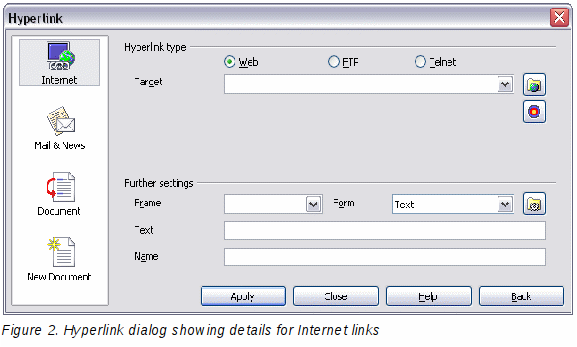
On the left side, select one of the four categories of hyperlink:
Internet: the hyperlink points to a web address, normally starting with http://
Mail & News: the hyperlink opens an email message that is pre-addressed to a particular recipient
Document: the hyperlink points to another document or to another place in the current document
New document: the hyperlink creates a new document
The top right part of the dialog changes according to the choice made for the hyperlink category in the left panel. A full description of all the choices and their interactions is beyond the scope of this chapter. Here is a summary of the most common choices.
For an Internet hyperlink, choose the type of hyperlink (Web, FTP, or Telnet), and enter the required web address (URL).
For a Mail and News hyperlink, specify whether it is a mail or news link, the receiver’s address, and for email, also the subject.
For a Document hyperlink, specify the document path (the Open File button opens a file browser) or leave this blank if you want to link to a target in the same document. Optionally specify the target in the document (for example a specific slide). Click on the Target in Document icon to open the Navigator where you can select the target; or if you know the name of the target, you can type it into the box.
For a New Document hyperlink, specify whether to edit the newly created document immediately (Edit now) or just create it (Edit later), enter the file name, and select the type of document to create (text, spreadsheet, and so on). Click the Select Path button to open a file browser and choose where to store the file.
The Further settings section in the bottom right part of the dialog is common to all the hyperlink categories, although some choices are more relevant to some types of links.
Set the value of Frame to determine how the hyperlink will open. This applies to documents that open in a Web browser.
Form specifies if the link is to be presented as text or as a button. Figure 3 shows a link formatted as a button. A hyperlink button is a type of form control. See Chapter 15 of the Writer Guide for more information.
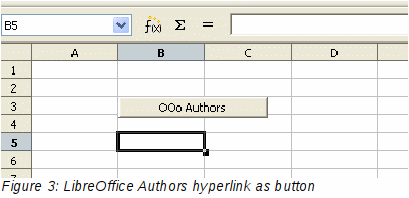
Text specifies the text that will be visible to the user. If you do not enter anything here, LibreOffice uses the full URL or path as the link text. Note that if the link is relative and you move the file, this text will not change, though the target will.
Name is applicable to HTML documents. It specifies text that will be added as a NAME attribute in the HTML code behind the hyperlink.
Events
button
![]() :
click this button to open the Assign Macro dialog and choose a macro
to run when the link is clicked. See Chapter 13 (Getting Started
with Macros) for more information.
:
click this button to open the Assign Macro dialog and choose a macro
to run when the link is clicked. See Chapter 13 (Getting Started
with Macros) for more information.
To
edit an existing link, click anywhere in the link text and then click
the Hyperlink
icon
![]() on the Standard toolbar
or choose Edit
→
Hyperlink from the menu bar. The Hyperlink dialog
opens. Make your changes and click Apply. If you need to edit
several hyperlinks, you can leave the Hyperlink dialog open until you
have edited all of them. Be sure to click Apply after each
one. When you are finished, click Close.
on the Standard toolbar
or choose Edit
→
Hyperlink from the menu bar. The Hyperlink dialog
opens. Make your changes and click Apply. If you need to edit
several hyperlinks, you can leave the Hyperlink dialog open until you
have edited all of them. Be sure to click Apply after each
one. When you are finished, click Close.
The standard (default) behavior for activating hyperlinks within LibreOffice is to use Ctrl+click. This behavior can be changed in Tools → Options → LibreOffice → Security → Options, by deselecting the option Ctrl-click required to follow hyperlinks. If clicking in your links activates them, check that page to see if the option has been deselected.
You can remove the clickable link from hyperlink text—leaving just the text—by right-clicking on the link and selecting Default Formatting. This option is also available from the Format menu. You may then need to re-apply some formatting in order for the text to match the rest of your document.
To erase the link text or button from the document completely, select it and press the Backspace or Delete key.
Saving Writer documents as web pages
Writer’s HTML capabilities include saving existing documents in HTML format, creating new documents as HTML (not described here), and creating several different types of web pages using a wizard.
The easiest way to create HTML documents is to start with an existing Writer document. You can get a good idea of how it will appear as a web page by using View → Web Layout. However, web layout view will not show you which features will or won’t save correctly to HTML. Some considerations are described in the introduction to this chapter.
Saving a document as a single web page
To save a document as a single web page (HTML format), choose File → Save As and specify HTML Document as the file type.
|
Note |
Writer does not replace multiple spaces in the original document with the HTML code for non-breaking spaces. If you want to have extra spaces in your HTML file or web page, you need to insert non-breaking spaces in LibreOffice. To do this, press Control+Spacebar instead of just Spacebar. |
Saving a document as a series of web pages
Writer can save a large document as a series of web pages (HTML files) with a table of contents page. To do this:
Decide which headings in the document should start on a new page and make sure all those headings have the same style (for example, Heading 1).
Choose File → Send → Create HTML Document.
In the Name and Path dialog, type the file name to save the pages under. Also specify which style indicates a new page (as decided in step 1).
Click Save to create the multi-page HTML document. (For those who may be interested, the resulting HTML files conform to the HTML 4 Transitional.)
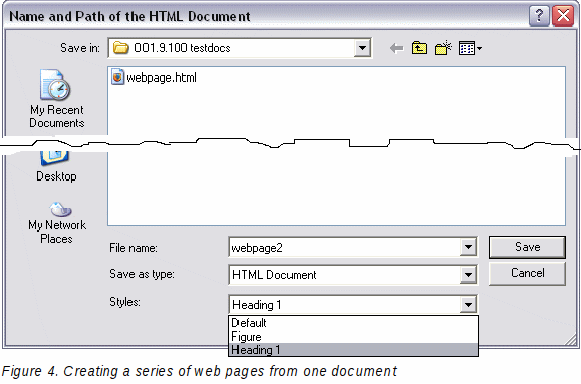
Creating web pages using a Wizard
LibreOffice’s Web wizard allows you to create several types of standard web pages. To use it:
Choose File → Wizards → Web Page. On the first page of the Wizard, choose settings and click Next. If this is your first web page, the only choice is <default>.
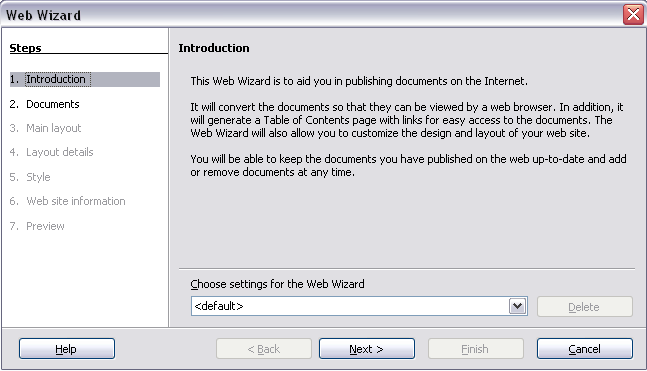
Choose or browse to the document you would like to format. The Title, Summary and Author information is picked up from the document’s properties; if necessary, edit it. Click Next.
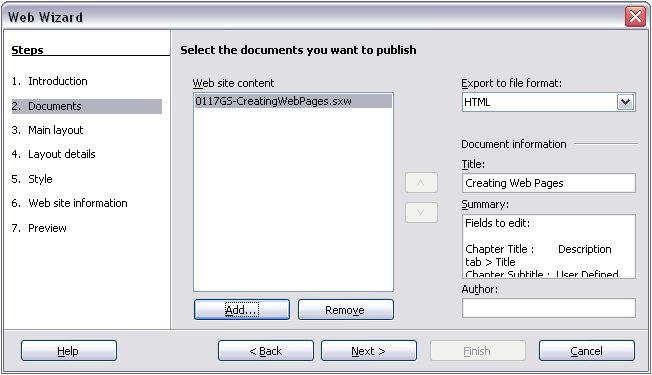
Chose a layout for the web site by clicking on the layout boxes. Click Next.
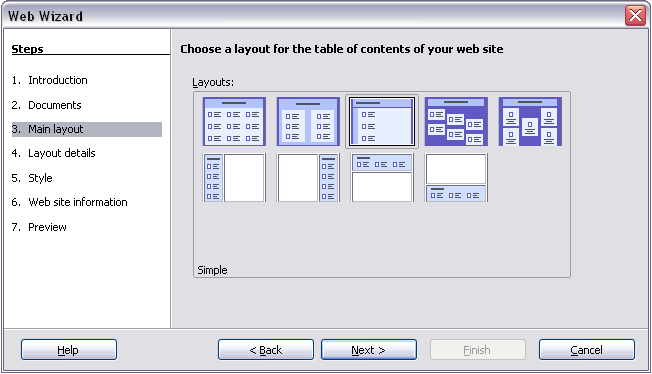
Chose the information to be listed and the screen resolution. Click Next.
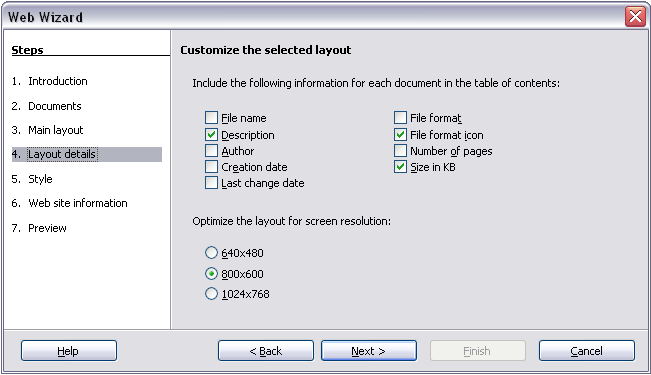
Select a style for the page. Use the drop-down list to choose different styles and color combinations. You can browse to a background image and icon set from the Gallery. Click Next.
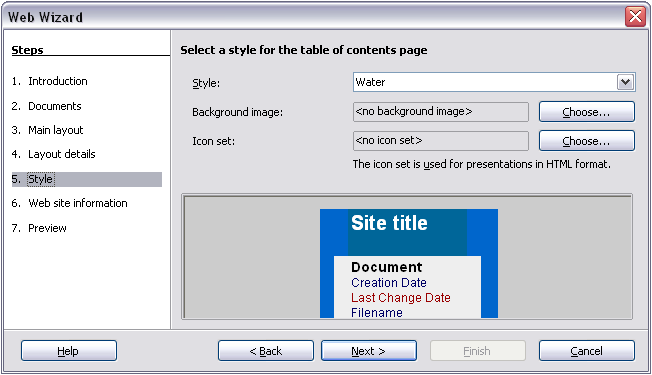
Enter general information such as Title and HTML Metadata information. Click Next.
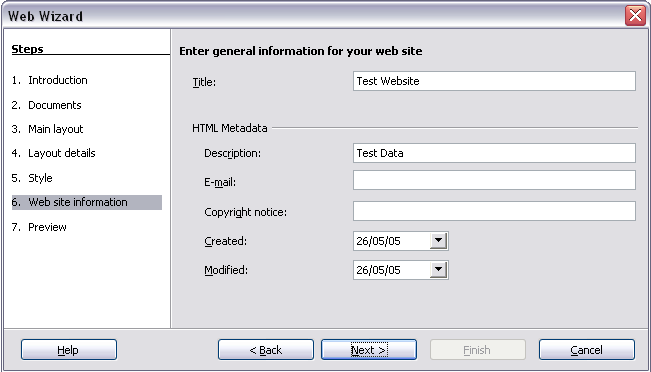
Chose where to save the file and preview the page if you wish. Click Finish.
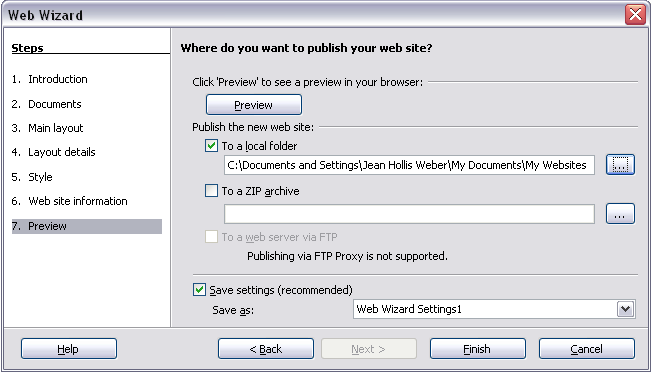
To
edit or view the document’s underlying HTML code, open the
document, and then choose View
→
HTML Source or click the HTML
Source icon
![]() on the Main
toolbar.
on the Main
toolbar.
Saving Calc spreadsheets as web pages
Calc can save files as HTML documents. As for Writer, choose File → Save As and select HTML Document, or choose File → Wizards → Web Page.
If the file contains more than one sheet, the additional sheets will follow one another in the HTML file. Links to each sheet will be placed at the top of the document. Calc also allows the insertion of links directly into the spreadsheet using the Hyperlink dialog.
Saving Impress presentations as web pages
You can export presentations as Macromedia Flash files: choose File → Export and select Macromedia Flash for the file type.
You can also convert presentations into a series of web pages, as described below.
|
Note |
Saving as web pages (HTML format) does not retain animation and slide transitions. |
To begin, choose File → Export and select HTML Document as the file type.
Create a folder for the files, supply a name for the resulting HTML file, and click Save. The HTML Export Wizard opens.
|
Note |
Depending on the size of your presentation and the number of graphics it contains, the HTML export function may create many HTML, JPG, and GIF files. If you simply save to your desktop (not in a specific folder), these separate HTML and graphics files will be all over your desktop. So be sure to create a folder to hold all the files. |
Choose the design for all of the pages, either from an existing design or by creating a new one. If you have not previously saved a design, the Existing Design choice is not available.
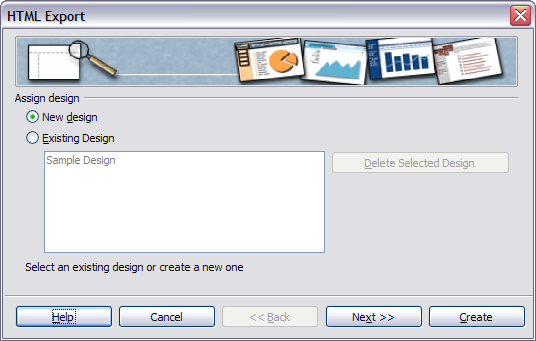
Click Next to select the type of web pages to create.
Standard HTML: one page for each slide, with navigation links to move from slide to slide.
Standard HTML with frames: one page with a navigation bar on the left-hand side; uses slide title as navigation links. Click on links to display pages in right-hand side.
Automatic: one page for each slide, with each page set with the Refresh meta tag so a browser automatically cycles from one page to the next.
WebCast: generates an ASP or Perl application to display the slides. Unfortunately LibreOffice has no direct support for PHP yet.
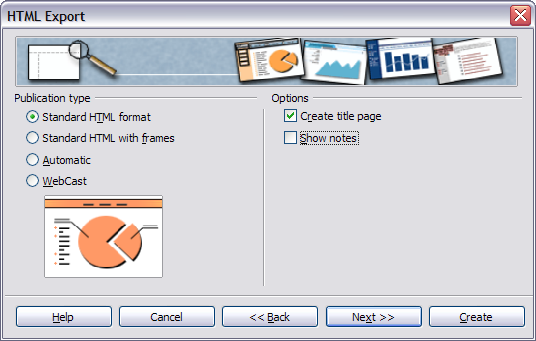
Decide how the images will be saved (PNG, GIF, or JPG) and what resolution to use.
When choosing a resolution, consider what the majority of your viewers might be using. If you specify a high resolution, then a viewer with a medium-resolution monitor will have to scroll sideways to see the entire slide, which isprobably not desirable.
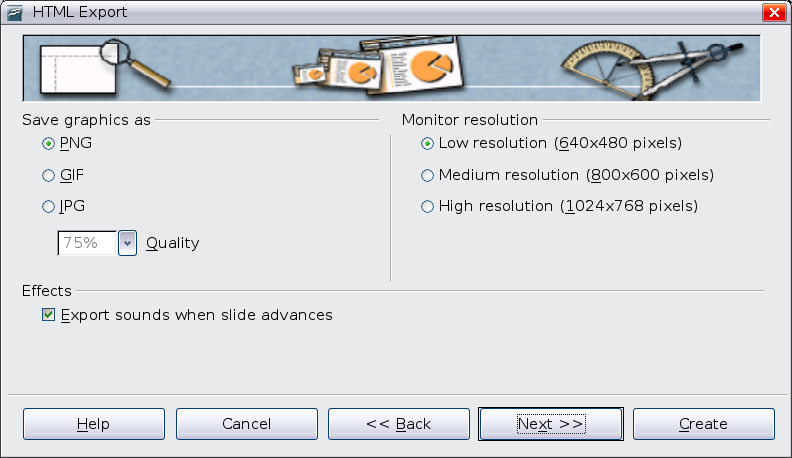
If Create title page was chosen in step 4, supply the information for it on the next page. The title contains an author name, e-mail address and home page, along with any additional information you want to include.
This page of the Wizard does not display if Create title page was not chosen.
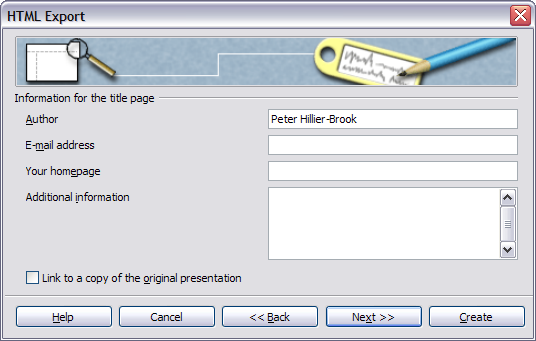
Choose the navigation button style to use to move from one page to another. If you do not choose any, LibreOffice will create a text navigator.
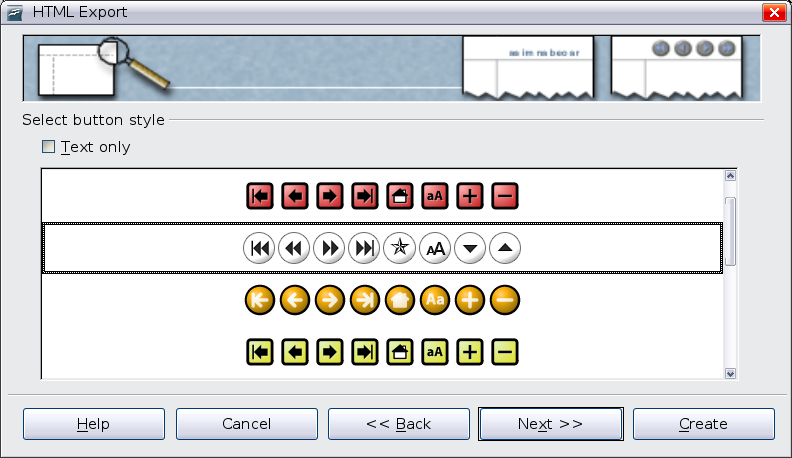
Select the color scheme for the web pages. Available schemes include the document’s existing scheme, one based upon browser colors, and a completely user-defined scheme. You can save a new scheme so that it will appear on the first page of the HTML export wizard.
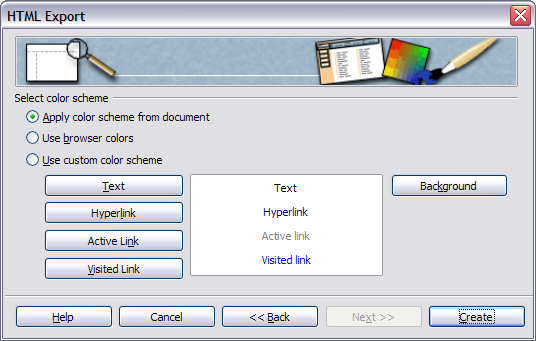
Click Create to generate the HTML files. If this is a new design, a small dialog pops up. If you might want to reuse this design, you can give it a name and save it. Otherwise, click Do Not Save.

Saving Draw documents as web pages
Exporting drawings from LibreOffice’s Draw application is similar to exporting a presentation from Impress. Choose File → Export and select HTML Document as the file type.
When using the wizard, you can choose to create the web page at any time by clicking the Create button.